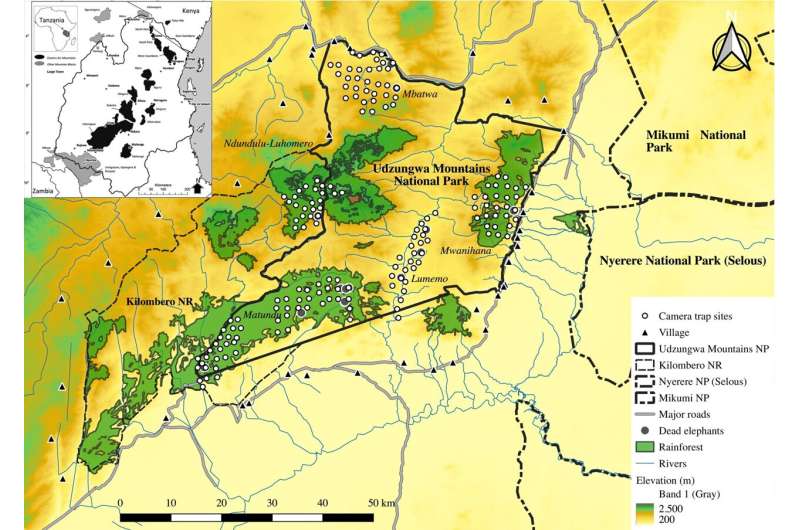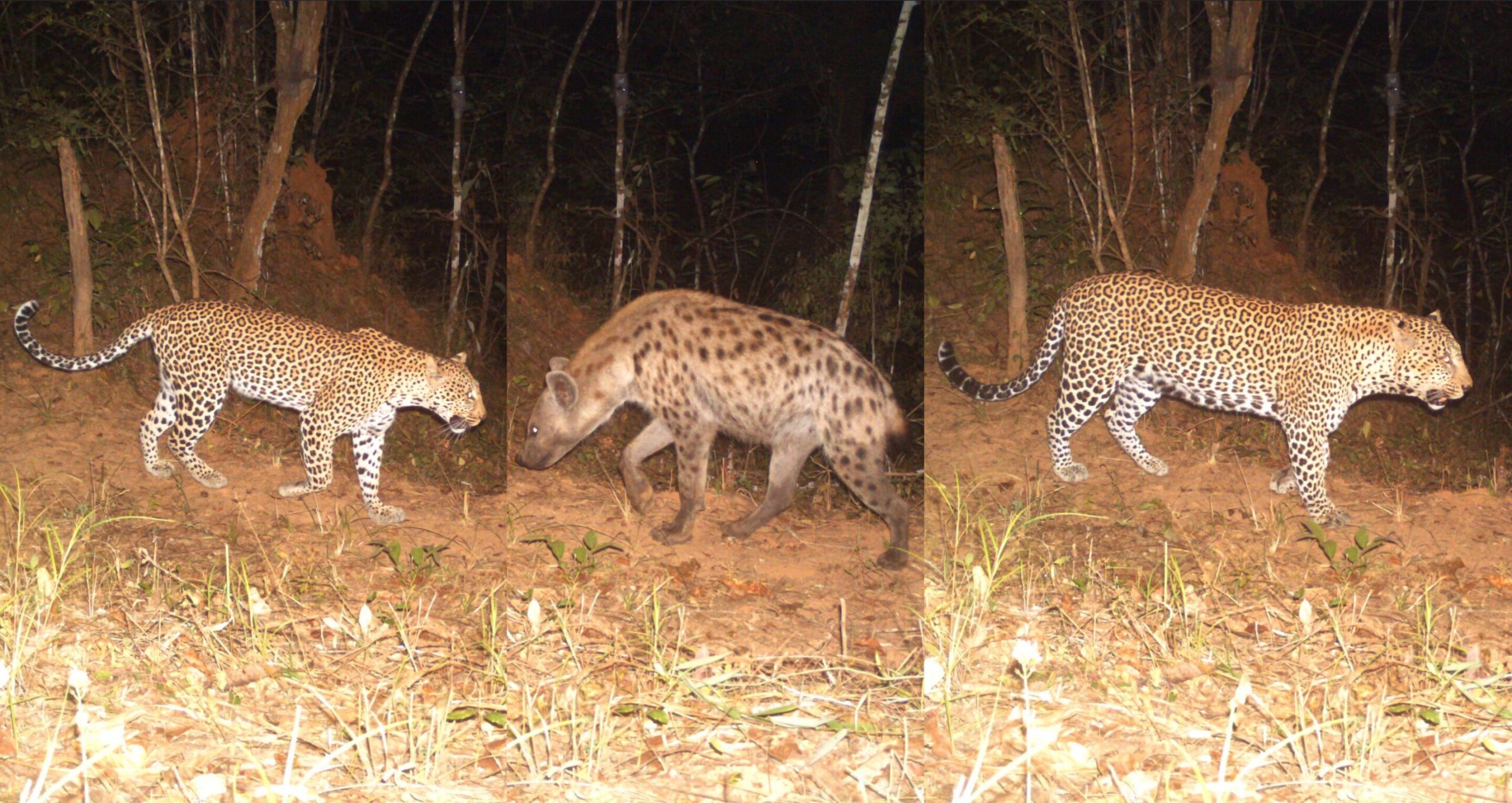Camera trap footage in Udzungwa. From left to right: Female leopard, hyena, male leopard. Credit: Rasmus W. Havmøller
Who is stronger? A lone leopard or the cackling of hyenas? And who can best handle people?
Researchers from the University of Copenhagen studied this closely in a large East African nature reserve surrounded by rural settlements. The study published in Ecosphereshows that the presence of humans has a direct impact on the competitive relationship between the two largest predator species: leopards (Panthera pardus) – the iconic spotted cat and the spotted hyena (Crocuta crocuta) – a kleptoparasite and pack hunter known for its comical appearance and characteristic ‘laugh’.
“We humans continue to eat our way into the little wilderness that remains in the world. As we do so, we impact wildlife. This study shows that human disturbance is upsetting the balance between competing species, and that this is to the advantage of hyenas,” says Rasmus W. Havmøller, the study’s first author and a postdoc at the Danish Museum of Natural History, University of Copenhagen.
For months, Havmøller has been using camera traps to observe the dynamics between hyenas and leopards living in the Udzungwa Mountains of Tanzania, an area of approximately 2,000 km2.2 national park that is completely surrounded by agricultural and populated areas. The study is the first to combine camera observations of large predators over both time and space in a single analysis.
While the hyena as a species seems to be increasing in numbers, the leopard population has been in significant decline for decades, both in Africa and worldwide. Since hyenas are the leopards’ only competitors in this particular area, the ability of the two species to coexist is important for their survival. And here, the local population is a major factor.
“Because the local population absolutely does not like leopards, the leopards retreat as far away from people as possible. Hyenas, on the other hand, benefit from people not feeling threatened by them or chasing them. That is why hyenas live close to human populations and can even exploit people as a shield against the leopards,” says Havmøller.
“But the areas closest to humans are also the areas with the most prey. And because hyenas claim dominance over these areas, this increases their ability to outcompete leopards and potentially threatens the leopard’s ability to adapt,” Havmøller adds.
Size matters
The researchers’ observations confirm that size matters. While male leopards, which are larger, maintain their dominance over hyenas, the situation is different for female leopards, which are smaller.
“Although the male leopards are in charge, the hyenas are not really frightened by them. They just hang around in the background, probably to follow the leopards and steal their prey. But the physical inferiority of the hyenas seems to be compensated for in the areas closest to people, because male leopards retreat,” says Havmøller.
“Female leopards, on the other hand, change their behavior completely when hyenas are around. They become diurnal, while hyenas are mainly nocturnal. This is probably because female leopards are smaller than hyenas, and are more likely to lose in a fight over prey.”
Overall, the research shows that hyenas benefit from living near humans.
“This suggests that hyenas’ ability to adapt to areas where humans are active may enhance their overall success as a species and their competitive advantage over other large predators as we humans increasingly disrupt nature,” Havmøller said.

Map of the Udzungwa Mountains, Tanzania. Credit: Ecosphere (2024). DOI file: 10.1002/ecs2.4913
When leopards are under pressure, cascading effects can occur
According to the researcher, the shift in hunting patterns of female leopards can have negative consequences. “If you allow more tourism and build more roads in the national park, the female leopards will come under direct pressure. They cannot distinguish between safari tourists, who are most active during the day, and poachers.
“Over time, they will probably learn that safari guests are not dangerous. But if there is a large and rapid influx into the area, you will probably see a decline in their population,” says Havmøller.
If leopards are seriously squeezed out of the food chain, one would expect the emergence of so-called cascading effects in the ecosystem. “The removal of a large predator like leopards from the food chain, which can be the ultimate consequence of human disturbance, can have very violent effects.
“Populations of other species, such as certain monkey species, that are kept in check by leopards suddenly become too large and disrupt the balance of the entire ecosystem,” the researcher said.
Havmøller hopes that the research will contribute to restraint in the management of nature reserves.
“Our results clearly indicate that human disturbances can alter the competitive relationship between key predators. So I hope that considerations will be given to expanding activities in wilderness areas, to rolling them out slowly and allowing animals to adapt.
“In addition, it would be good if the effects of human disturbances were mapped in more places using camera traps,” Havmøller concludes.
Hyenas vs Leopards
- Leopards are unpopular with locals in many places because they prey on livestock and attack people. Hyenas, on the other hand, “clean up” by eating sick or dead livestock and are not a problem for people.
- Female leopards (c. 20 kg–43 kg) are about half the size of male leopards (c. 51 kg–72 kg). Hyenas are in the middle in weight (c. 48 kg–56 kg).
- Leopards are solitary hunters, while hyenas hunt in large groups (clans). This can be an advantage for hyenas in confrontations with leopards.
- Hyenas are kleptoparasites that regularly steal the prey of other carnivores, including leopards.
- Leopards, on the other hand, are master tree climbers, which allows them to protect their prey from hyenas.
More information:
Rasmus Worsøe Havmøller et al, Sex and size matter: complex dominance relationships in an East African guild of large carnivores, Ecosphere (2024). DOI file: 10.1002/ecs2.4913
Offered by the University of Copenhagen
Quote: Human presence disrupts balance between leopards and hyenas in East Africa (2024, July 2) Retrieved July 3, 2024 from https://phys.org/news/2024-07-human-presence-shifts-leopards-hyenas.html
This document is subject to copyright. Except for fair dealing for private study or research, no part may be reproduced without written permission. The contents are supplied for information purposes only.
